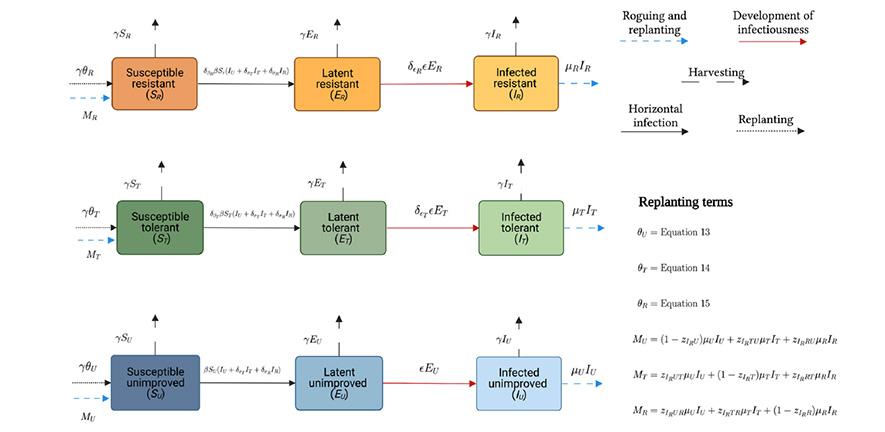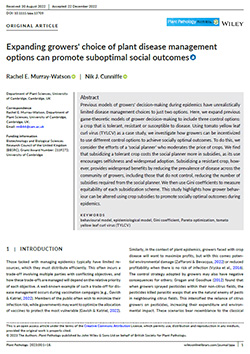
Submitted by Anonymous on Fri, 31/03/2023 - 11:08
Subset of resistant-crop growers needed for social optimum
Farmers’ behaviour is integral to crop disease control, but has received surprisingly little attention from researchers until recently - an individual farmer makes decisions that affect not only their own farming practice, but can also affect that of their neighbours.
In earlier behavioural modelling studies, farmers were assumed to either plant disease-resistant crops or to plant disease-susceptible crops, but these options are merely two extremes of a range of options available, and do not often occur in practice.
In a new study looking at Tomato Yellow Leaf Curl Virus, Dr Rachel Murray-Watson and Professor Nik Cunniffe expanded the number of options to reflect the need for greater realism and applicability, modelling a suite of three: The use of disease-resistant (in which disease does not reduce yield, or reduces it minimally), disease-tolerant (disease causes some reduction in yield) and disease susceptible (disease causes significant reductions in yield) varieties, whilst also considering the position of a ‘social planner’ who moderates the price of crops.
‘The role of the planner is akin to the "nudges" that have become popular in aspects of behavioural economics and public health. The planner doesn’t narrow the choices of growers but tries to "push" them towards one option or another, often using subsidies,’ explained Dr Murray-Watson.
A balance of tolerant and resistant crops
The study found that an individual tomato farmer growing a resistant crop protected other non-resistant fields but did not encourage other growers to plant resistant crops, as they could benefit from the reduction in disease caused by their neighbour’s crop without making any changes. Growing a tolerant crop, however, encouraged other growers to grow tolerant crops.
Growing the tolerant crop was found to be the optimal choice for the individual growers, but led to worse outcomes for the planner and the community as a whole, and the social optimum occurred when a subset of growers grew the resistant crop.
‘The optimum set of control strategies require the planner to provide sufficient subsidies to the resistant crop to ensure that it is used, and never to subsidise the tolerant crop, which is the best choice for the farmers as it maximises their profits, but in fact costs more for the planner.’ said Dr Murray-Watson.
‘In practice, even modelling just three scenarios is a considerable simplification, but the model shows how we can combine economic modelling practices with farmer behaviour decision models to find optimal solutions, and is applicable for other pathosystems and control mechanisms.’ said Professor Cunniffe.
Read the paper:
Murray-Watson, R. and Cunniffe, N. 2023. Expanding growers' choice of plant disease management options can promote suboptimal social outcomes. Plant Pathology. DOI: 10.1111/ppa.13705

